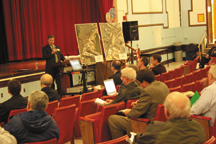Anybody who uses the New Jersey Turnpike Extension to come and go from Bayonne with any frequency already knows what a nightmare it can be at certain times of the day. Even if there is no accident or breakdown on the Turnpike bridge that connects Bayonne, Jersey City, and the Holland Tunnel to the main branch of the Turnpike near Newark Airport, backups at rush hour are routine and can often leave drivers frustrated and enraged.
A study by the Turnpike Authority said the 14A interchange for Bayonne has the most problems of any interchange north of 8A in Monroe Township.
And the future development of the former Military Ocean Terminal and other parts of the city of Bayonne hinges on the solving the problem of this traffic snarl.
“We need this to be done so that we can move forward with our plans for development.” – Chris Patella
________
But the final plan to clear up the traffic mess won’t be ready until 2015, officials said.
Public meeting
Staff members from the New Jersey Turnpike Authority came to Washington School on Dec. 2 to outline the basic concepts behind the improvement and ask the public for their ideas.
Officials said they were looking for experience on a daily basis with the interchange, but could not guarantee all the ideas would be incorporated into the final plan.
The project was the result of a Turnpike Authority study of all the exits north of 8A, which showed the Bayonne exit to the least functional. The major goals are to relieve traffic congestion, add capacity, increase safety, reduce travel time and improve air quality. If everything goes according to schedule, the interchange would be completed by 2015.
Turnpike officials said that while all options are being explored, any concept for improvement will have to consider a number of constraints – nearby residential properties, petroleum storage tanks, underground utilities, several rail lines, several other major roadways, and possible environmental contamination.
The preliminary engineering report is expected to be completed by the end of 2010, at which time the Turnpike expects to hire a design consultant to come up with a final design and other documents. This is expected to take about two years, and would conclude by the end of 2012. After this, construction will take about three years.
This is the first stage in a project that would improve traffic flow on and off Exit 14A. It affects a number of local streets, including Route 440 and Avenue E in Bayonne, as well as Garfield Avenue in Jersey City.
As it stands, vehicles that exit at 14A funnel into a single-lane overpass to get to Route 440, the Port Jersey Global Terminal, and the former Military Ocean Terminal (MOTBY).
Bayonne Local Redevelopment Authority Executive Director Christopher Patella said the upgrade is critical for the city of Bayonne.
“We need this to be done so that we can move forward with our plans for development,” Patella said. “We have met with Turnpike officials to make them aware of our concerns, and we’re looking forward to the Authority moving ahead with this project.”
Development at the MOTBY hinges on the improvements at the Turnpike interchange.
While the BLRA was able to move ahead with providing another exit from MOTBY for truck traffic and got the state to begin work on widening Route 440, the interchange posed a serious roadblock to redevelopment until last year, when the Turnpike Authority announced that it would include the $500 million project in its capital projects budget and bond for the money.
The improvements of Turnpike 14A Bayonne Interchange and the Newark Bay Turnpike extension bridge were not included in a capital plan that was first unveiled by the Turnpike Authority last year.
However, intense lobbying in Trenton apparently paid off for Bayonne, since the Turnpike Authority will use a portion of $9.7 billion in additional toll revenues to pay for the reconstruction of the Bayonne interchange (a cost estimated at about $500 million) and the widening of the Newark Bay extension that serves Bayonne, Jersey City and the Holland Tunnel approach, at a estimated cost of $1 billion.
The plan will also set aside $250 million for the redecking of the Newark Bay Bridge, which is the extension bridge serving exits 14A, 14B and 14C.
According to the New Jersey Department of Transportation, the Newark Bay Extension handles approximately 65,000 vehicles per day.
Tough going
Barbara Noble, who attended the public meeting, said she just wants to be able to get out of her driveway. Because traffic often backs up on Avenue E due to problems at the interchange, she came to make several suggestions, including developing a second lane for traffic approaching the toll booths during peak hours. She suggested that some traffic should be diverted to 14B.
Hugh Roarty, also an attendant of the meeting, brought a list of long-term and short-term recommendations, including reconfiguring a divider in the westbound and eastbound ramps that would prevent congestion by trucks during the peak hours.
Like Noble, he suggested that some traffic – particularly traffic coming from the direction of the Holland Tunnel – be forced to use the Caven Point Road exit at 14B. He also proposed changing the traffic direction on 53rd Street from the toll plaza all the way to JFK Boulevard, allowing traffic access to Broadway, Avenue C, Avenue B and Kennedy Boulevard. Currently, 53rd Street allows traffic to go westbound only to Broadway.
A long term solution, Roarty said, would be to extend Route 185 to the 14B interchange in Jersey City.
